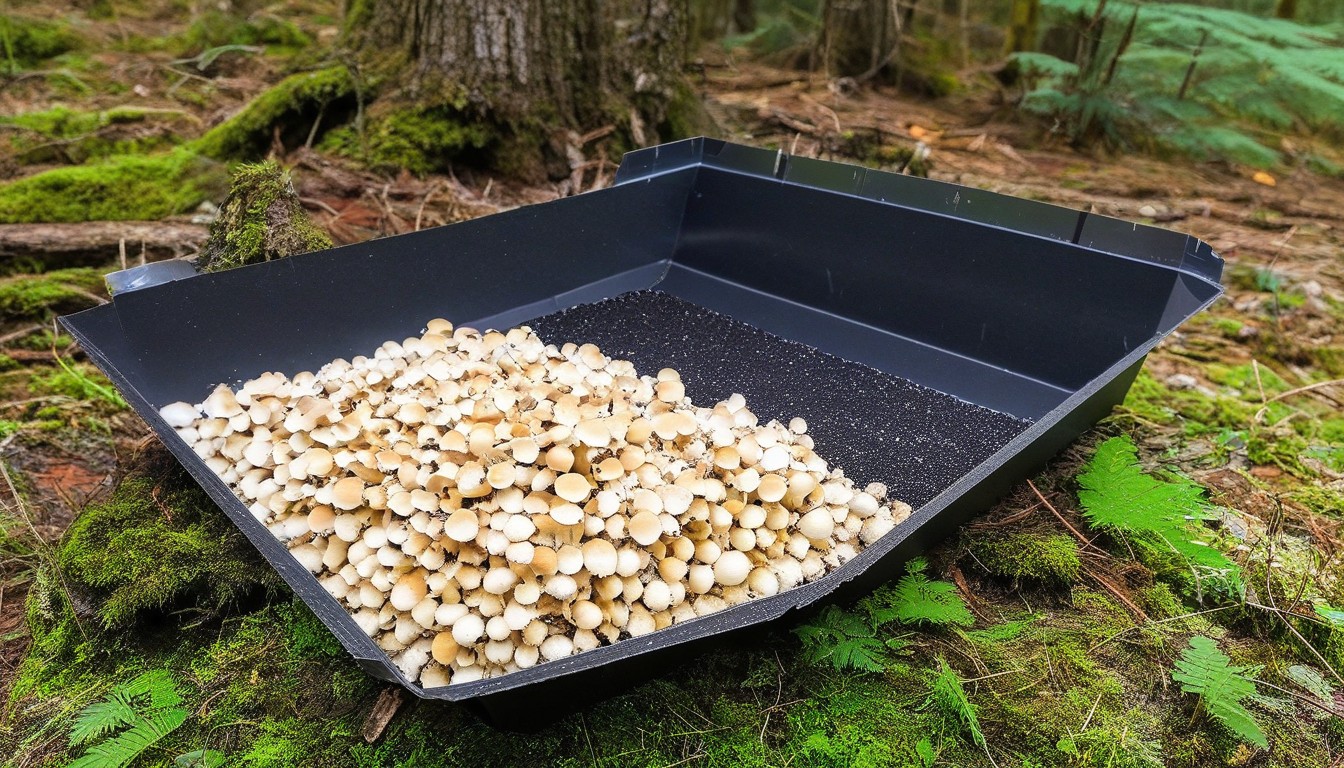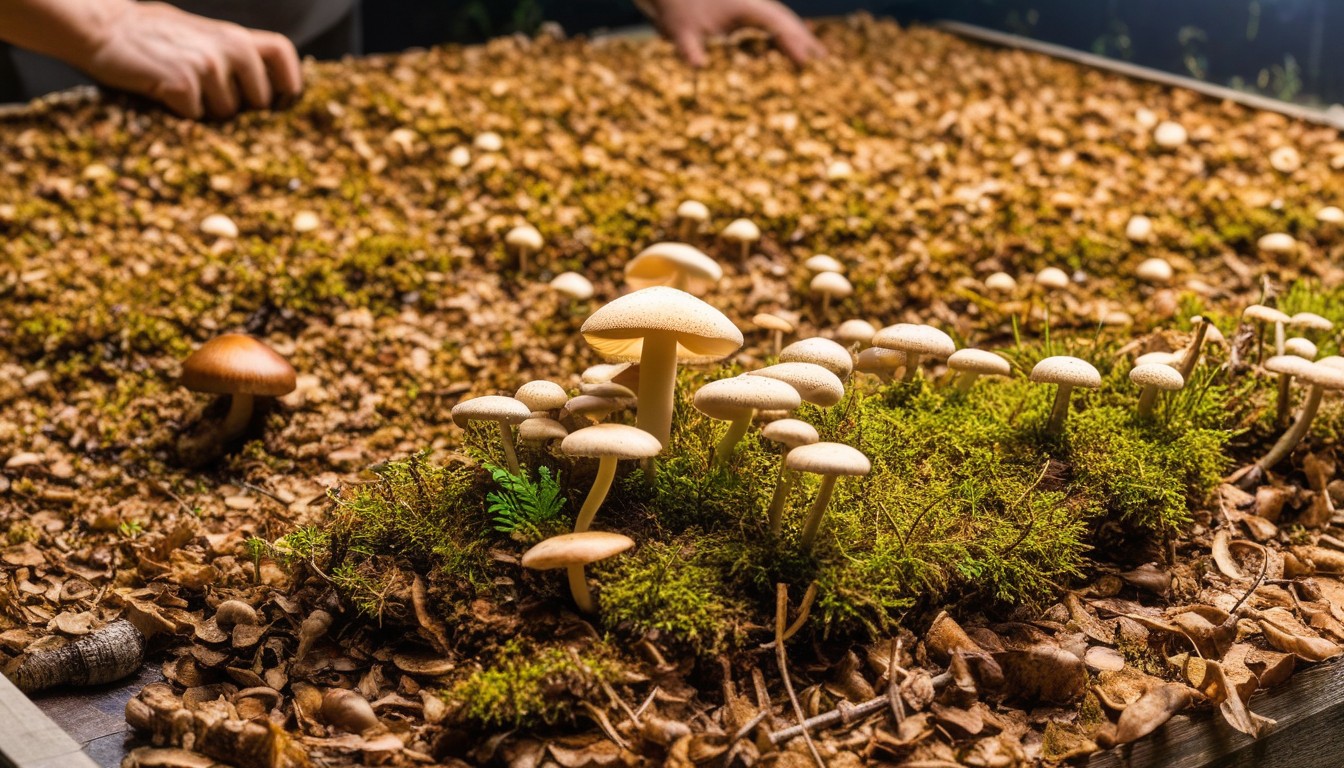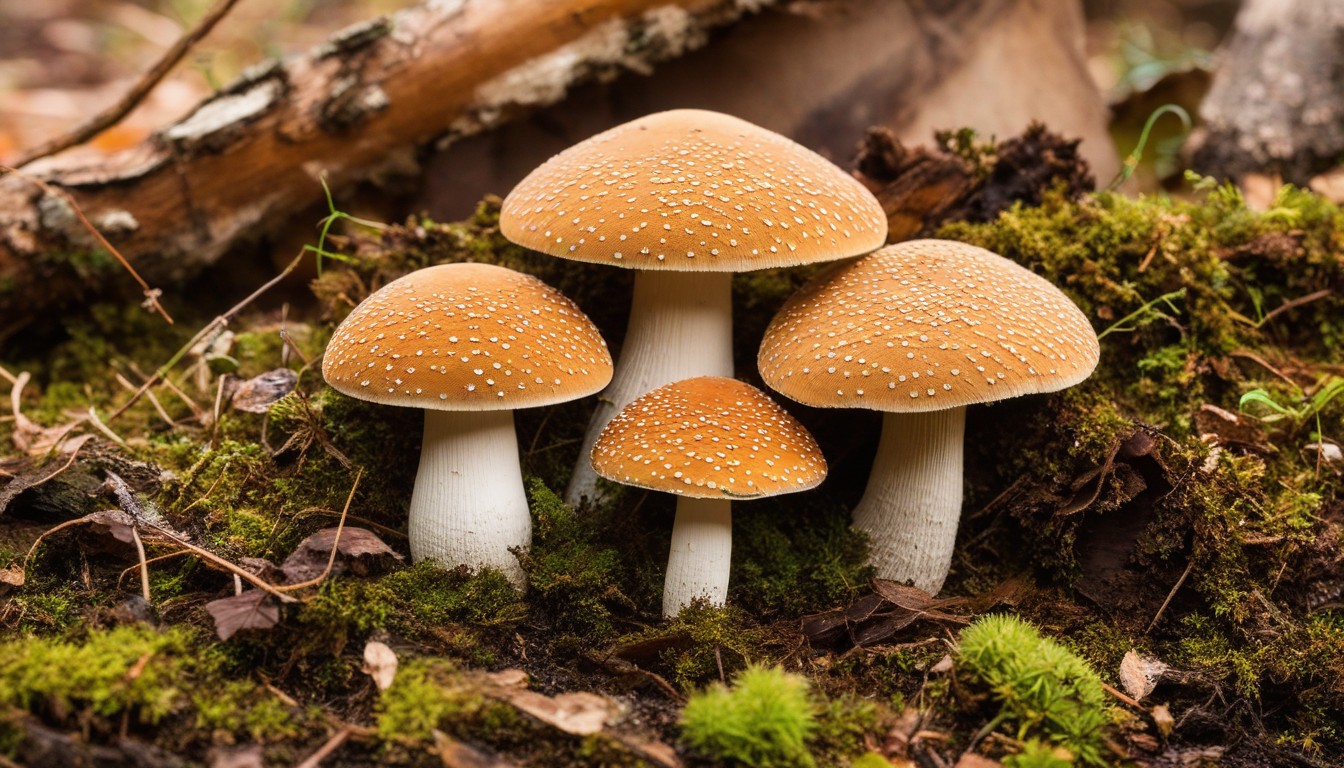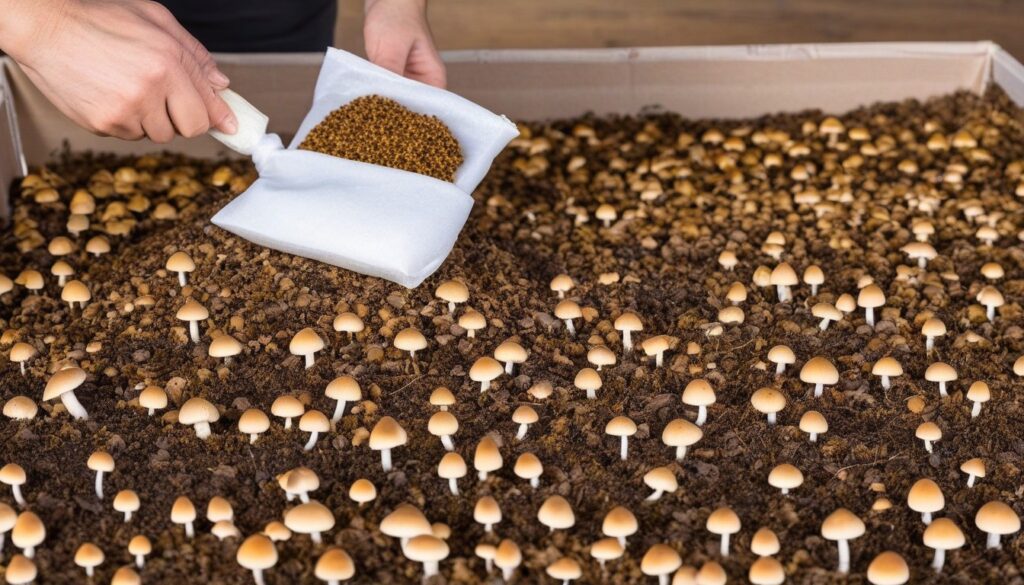If you love mushrooms and want to take your passion to the next level, learning how to make your own substrate is an excellent starting point. Growing your own mushrooms is a fulfilling and exciting experience that can save you money and give you access to a variety of unique mushroom species.
But what exactly is mushroom substrate, and why is it essential for successful mushroom cultivation? In this guide, we’ll explore the different types of substrates commonly used, how to choose the right ingredients, and the correct techniques for preparing, mixing, and incubating your substrate for optimal results.
Key Takeaways
- Mushroom substrate is crucial for successful mushroom cultivation
- Choosing the right ingredients is essential for creating a favorable environment
- Proper substrate preparation and mixing are crucial for promoting mycelium growth
- Optimal environmental conditions are necessary for fruiting and maximizing mushroom production
- Controlling pests and diseases and troubleshooting common issues are vital for a successful harvest
Understanding Mushroom Substrate
Before we begin with the process of making substrate for mushrooms, it’s essential to understand what mushroom substrate is and why it’s vital for successful mushroom cultivation.
Mushroom substrate is a mixture of organic materials that provides the necessary nutrients for mushroom mycelium to grow. It serves as the food source for the mycelium, allowing it to develop into a mature mushroom. The type of substrate used depends on the specific mushroom species being cultivated.
Mushroom cultivation, also known as mycology, requires attention to detail and a thorough understanding of the substrate requirements for each type of mushroom. Growing mushrooms starts with creating the right environment for mycelium to thrive.
By understanding the importance of mushroom substrate, you can set your mushroom cultivation journey on the right track and achieve a bountiful harvest.
“Mushroom substrate is a mixture of organic materials that provides the necessary nutrients for mushroom mycelium to grow.”
Choosing the Right Ingredients
When making substrate for mushrooms, choosing the right substrate ingredients is essential for successful cultivation. The ideal substrate should have a balance of nutrients, moisture, and structure to support the growth of mycelium, the vegetative part of the fungus.
There are various organic materials commonly used to make substrate, such as straw, sawdust, and manure. Each material has its unique characteristics and nutritional content, making it suitable for specific mushroom species. For example, Agaricus bisporus, the common white button mushroom, thrives on a blend of horse manure and straw, while shiitake mushrooms prefer hardwood sawdust and wheat bran.
Straw
Straw is one of the most commonly used substrate ingredients in mushroom cultivation. It’s readily available, affordable, and provides a good source of carbon for the mycelium to feed on. Wheat straw and oat straw are the most commonly used types for mushroom cultivation.
When using straw as a substrate ingredient, it’s essential to ensure it’s of good quality and not contaminated with fungi or other microbial agents. Also, it should be chopped into small pieces to reduce the time needed for sterilization or pasteurization.
Sawdust
Sawdust is another popular substrate ingredient used in mushroom cultivation, especially for species that prefer a woody substrate. Hardwood sawdust is preferred due to its high lignin content, a complex organic compound that provides structure and nutrition for the mycelium.
When using sawdust as a substrate ingredient, it’s essential to add other supplements such as wheat bran or soybean meal to improve the nutrient content and reduce the time needed for the mycelium to colonize the substrate.
|
Substrate Ingredient |
Nutrient Content |
Best Mushroom Species |
|---|---|---|
|
Wheat Straw |
High carbon |
Common white button, oyster, shiitake |
|
Oat Straw |
High nitrogen |
Common white button, oyster |
|
Hardwood Sawdust |
High lignin |
Shiitake, lion’s mane |
Ultimately, the choice of substrate ingredients depends on the mushroom species you want to cultivate and the availability of the organic materials. By selecting the right combination of substrate ingredients, you can create an ideal environment for mycelium growth and maximize your mushroom harvest.
Preparing the Substrate Ingredients

Now that you have your substrate ingredients, it’s time to prepare them for use. Proper preparation is essential to eliminate unwanted contaminants and create a favorable environment for the mycelium to grow.
There are two main methods of substrate preparation: sterilization and pasteurization.
Sterilization
Sterilization involves heating the substrate to high temperatures until all bacteria, fungi, and other microorganisms are eliminated. This method is ideal for substrates with high nutrient content, such as grains or seed mixes.
To sterilize your substrate, you will need a pressure cooker or autoclave. Fill the cooker with water, add your substrate to sterilization bags, and then place them in the cooker. Follow the manufacturer’s instructions for your specific equipment, but most will require a temperature of at least 121°C for 60-90 minutes to ensure proper sterilization.
Pasteurization
Pasteurization involves heating the substrate to a lower temperature than sterilization, typically around 60°C. This method is suitable for substrates with lower nutrient content, such as straw or sawdust.
To pasteurize your substrate, you can use a large pot or even a bathtub. Fill the container with water and heat it to about 60°C. Add your substrate to the water and keep it submerged for one to two hours, depending on the type and amount of substrate. You can also use a pasteurization machine, which will automate the process and ensure consistent results.
After pasteurization or sterilization, the substrate must be properly cooled before use. Allow it to cool to room temperature and then proceed with mixing and filling your containers or bags.
Mixing the Substrate
Once the substrate ingredients are prepared, it’s time to mix them together. This step is crucial to achieve the correct moisture content and distribute the spawn evenly, allowing for successful mycelium growth.
To begin, gather all the substrate ingredients and the appropriate tools, including a mixing container, a scale, and a misting bottle.
First, weigh the substrate ingredients and determine the required ratio for your mushroom species. For example, for oyster mushrooms, a common ratio is three parts sawdust, one part bran, and one part gypsum.
Next, add the substrate ingredients to the mixing container and mist with water until the moisture content reaches the optimal level. The ideal moisture content varies depending on the mushroom species, but as a general rule, the substrate should be “field capacity,” which means when squeezed, a few drops of water come out.
Once the substrate mixture is at the correct moisture level, add the spawn and mix thoroughly to distribute it evenly throughout the substrate. Use a gentle touch to avoid breaking the spawn’s delicate mycelium.
Finally, transfer the mixed substrate to the containers or bags for incubation and colonization. Keep in mind that the substrate should be compressed to eliminate any air pockets and ensure an even distribution.
Filling the Containers or Bags

Once the mushroom substrate ingredients are thoroughly mixed, it’s time to fill them into containers or bags. Proper filling techniques are essential to create an ideal growing environment and promote healthy mushrooms. Here are some tips for container and bag filling:
Container Filling
When filling containers, use a spoon or scoop to add substrate gradually, ensuring it is well-compressed to push out any trapped air.
It’s best to fill containers within 6″ deep to ensure proper air flow, but this can vary depending on the mushroom species. For example, shiitake mushrooms do better in deeper containers, while oyster mushrooms can thrive in shallower ones.
After filling, leave about an inch of space at the top of the container to allow for the expansion of the substrate during sterilization or pasteurization.
Bag Filling
Bag filling is a bit more challenging than container filling. One technique is to use an empty can or jar to hold the bag open while filling. Another option is to use a funnel to pour the substrate into the bags.
It’s crucial to compress the substrate while filling bags to remove any air pockets and create a uniform distribution. You can use your hands, a rolling pin, or a potato masher to press down the mixture firmly.
|
Tip: |
It’s helpful to have a second person holding the bag open while you fill it and compress the substrate. |
|---|
After filling the bag, leave some space at the top to tie a knot or close with a twist tie. The bags should also have some small punctures to allow for proper air exchange while incubating and fruiting.
Substrate Compression
Whether filling containers or bags, proper substrate compression is crucial for promoting mycelium growth and preventing contamination. Compressing the substrate helps to remove air pockets and ensure uniform distribution.
It’s best to compress the substrate in layers as you fill the container or bag. This ensures that each layer gets compressed evenly without disturbing the layer beneath it.
After filling the container or bag, compress the substrate once more to remove any remaining air pockets. This may require a bit of force, but be careful not to compress the substrate too much as this could prevent proper air flow and water retention.
Now that the containers or bags are filled with compressed substrate, it’s time to move on to the next step: incubation and colonization.
Incubation and Colonization
Now that your substrate is prepared and filled into containers or bags, it’s time for the incubation and colonization phase. This is the crucial period when the mycelium begins to grow and spread throughout the substrate, establishing a robust network of tiny threads that will eventually form the mushrooms.
To promote healthy mycelium growth, it’s essential to maintain optimal environmental conditions. Keep the substrate in a warm, dark place, ideally between 70-75°F with a humidity level of around 90%. You can achieve this by covering the substrate with a lid or plastic wrap and misting it daily with water to maintain moisture levels.
The duration of the incubation phase depends on several factors, including the type of mushroom and the substrate used. Typically, it can take anywhere from a few days to several weeks for the mycelium to fully colonize the substrate. During this time, monitor the progress by checking the substrate for any signs of contamination or abnormal growth.
Signs of Successful Colonization
When the mycelium has colonized the substrate successfully, you’ll notice a few key signs:
- The substrate will be fully covered in a white, web-like growth.
- The mycelium will be thick and ropey, spreading throughout the substrate.
- The substrate will emit a sweet, mushroomy smell.
If you notice any signs of contamination, such as mold or bacteria growth, it’s essential to act quickly to prevent further damage. Remove any contaminated substrate immediately, and dispose of it carefully to avoid spreading the contamination.
Once the mycelium has fully colonized the substrate, it’s time to move onto the fruiting stage. This stage is when the mushrooms begin to develop from the tiny pins that form on the substrate’s surface, and our next section will cover everything you need to know about this exciting phase!
Creating Optimal Environmental Conditions

Creating the right environmental conditions is essential for successful mushroom cultivation. When it comes to temperature, most mushroom species grow best between 60-80°F (15-26.6°C), although some species have different requirements. It’s important to maintain a consistent temperature throughout the growing cycle, so consider investing in a thermometer or thermostat to monitor your setup.
Humidity is another critical factor in mushroom growth. Most species thrive in high humidity environments between 70-90%, but again, some require different levels. To maintain proper humidity, consider using a humidifier or misting the growing area regularly. It’s important to avoid over-saturating the substrate, as this can lead to bacterial contamination.
Ventilation
Proper ventilation is crucial for maintaining optimal environmental conditions. Not only does ventilation regulate temperature and humidity, but it also helps prevent the buildup of harmful gases like carbon dioxide. To ensure adequate ventilation, you may want to consider using a fan or opening windows if possible.
Lighting
While mushrooms don’t require light to grow, it can help promote healthy fruiting. Most species benefit from 12-14 hours of light per day, but be sure to avoid direct sunlight, which can be harmful. Consider using LED lights or natural light filtered through a cloth or filter paper.
Monitoring
It’s crucial to monitor environmental conditions regularly throughout the growing cycle to ensure optimal growth and prevent issues. Consider keeping a log of temperature, humidity, and other factors, and make adjustments as necessary. With proper environmental control and monitoring, you can enjoy a bountiful harvest of healthy and delicious mushrooms.
Fruiting and Harvesting
After proper incubation and colonization, the fruiting stage is where the magic happens. Fruiting mushrooms emerge from the substrate, forming tiny bumps called mushroom pins. From these pins, the mushroom caps develop and mature into flavorful and nutritious edibles.
As the mushroom pins begin to develop, it’s essential to maintain the optimal environmental conditions to encourage growth. Ensure that the temperature is in the range of 65 to 70 degrees Fahrenheit, with a humidity level of around 90%. It’s also vital to provide adequate ventilation to prevent stale air from accumulating and affecting growth.
Harvesting the fruiting mushrooms is one of the most satisfying parts of the cultivation process. When the caps are fully mature, with the veil under the cap beginning to break, use a sharp pair of scissors or a knife to cut the stem close to the substrate surface. Harvesting should be done before the cap begins to flatten out to ensure optimal flavor and texture.
|
Mushroom Variety |
Fruiting Time |
Harvesting Tips |
|---|---|---|
|
White Button |
10-21 days |
Harvest when caps are fully mature and the veil begins to break. |
|
Crimini |
14-21 days |
Harvest when caps are fully mature and the veil begins to break. |
|
Shiitake |
14-21 days |
Harvest when the caps bend slightly downwards and just before the edges begin to flatten. |
It’s essential to maintain a clean and sterile environment when harvesting, to prevent contamination and ensure a healthy crop. Take care to remove any remaining substrate from the container or bag and dispose of it properly.
With the right conditions and techniques, fruiting and harvesting mushrooms can be a rewarding and enjoyable experience. Enjoy the fruits of your labor and savor the unique flavors and textures of your homegrown mushrooms.
Controlling Pests and Diseases

As with any crop, pest management and disease prevention are critical factors in successful mushroom cultivation. Pests and diseases can quickly decimate a crop, so it’s essential to take measures to prevent and control these issues.
Pest Management
Common pests in mushroom cultivation include mites, flies, and larvae. One effective method of pest control is to maintain a clean growing environment. Regularly clean and disinfect growing areas to eliminate any potential breeding grounds for pests. Additionally, some growers introduce beneficial insects, such as nematodes, to prey on harmful pests.
Disease Prevention
Preventing diseases is crucial to a successful mushroom harvest. Common diseases affecting mushroom cultivation include bacterial blotch, verticillium wilt, and cobweb mold. Proper sterilization of the substrate, containers, and tools is essential to minimize the risk of contamination. Additionally, maintaining proper environmental conditions, such as temperature and humidity, can prevent the growth and spread of harmful fungi and bacteria.
Table: Common Pests and Diseases in Mushroom Cultivation
|
Pests |
Diseases |
|---|---|
|
Mites |
Bacterial blotch |
|
Flies |
Verticillium wilt |
|
Larvae |
Cobweb mold |
By following appropriate pest management and disease prevention measures, you can significantly reduce the risk of crop failure. Regular monitoring of your crop can help you identify any potential issues early, and prompt action can prevent the spread of pests and diseases.
Troubleshooting Common Issues
As with any hobby, problems can arise during the mushroom cultivation process. Understanding the common issues and how to troubleshoot them can save your crop and ensure a successful harvest.
Mycelium Contamination
Mycelium contamination is a common issue in mushroom cultivation, caused by the growth of unwanted fungi and bacteria in the substrate. It can be detected by the presence of abnormal colors and odors or the lack of mycelium growth. To prevent contamination, make sure to sterilize or pasteurize the substrate properly before inoculating it with spawn. If contamination occurs, remove the affected area and re-sterilize or pasteurize the substrate to prevent further spread.
Substrate Imbalance
A substrate imbalance can occur when the substrate ingredients are not mixed properly, leading to uneven moisture or nutrient distribution. This can result in slow mycelium growth or the inability to produce mushrooms. To avoid substrate imbalance, make sure to mix the ingredients thoroughly and maintain the correct moisture content throughout the process.
Slow Growth
If you notice slow mycelium growth, it may indicate that the environmental conditions are not optimal. In some cases, it could also be due to poor quality spawn or substrate. Check the temperature and humidity levels, and ensure that the substrate is free from contaminants. If the issue persists, consider obtaining fresh spawn or using a different substrate recipe.
Table: Common Mushroom Cultivation Problems
|
Problem |
Cause |
Solution |
|---|---|---|
|
Mycelium Contamination |
Presence of unwanted fungi and bacteria in the substrate |
Remove the affected area and re-sterilize or pasteurize the substrate to prevent further spread |
|
Substrate Imbalance |
Uneven moisture and nutrient distribution from improperly mixed substrate |
Mix the ingredients thoroughly and maintain the correct moisture content |
|
Slow Growth |
Environmental conditions, poor quality spawn, or substrate issues |
Check temperature and humidity levels, ensure substrate is free from contaminants, consider obtaining fresh spawn or using a different substrate recipe |
By following these troubleshooting tips, you can overcome common mushroom cultivation problems and enjoy a successful harvest. Remember to stay patient and persistent, and your efforts will be rewarded. Happy growing!
Conclusion
Congratulations on completing this guide to making substrate for mushrooms at home! We hope you found this step-by-step process informative and helpful in your mycology journey.
Enjoy the Fruits of Your Labor
By now, you should have a deep understanding of what mushroom substrate is and how to create it using the right ingredients, preparation methods, and environmental conditions. With your newly acquired knowledge, you can create an optimal growing environment and enjoy a bountiful harvest of delicious mushrooms.
Experiment and Explore
Remember, mushroom cultivation is an art that requires patience, dedication, and experimentation. Don’t be afraid to try new things and explore different techniques to find what works best for you and your mushrooms.
Grow Your Passion
Whether you are a seasoned mushroom grower or a beginner, there’s always room for growth and improvement. With this guide, you can turn your passion for mycology into a fulfilling hobby that brings joy, satisfaction, and a delicious supply of homegrown mushrooms.
Happy Cultivating!
Thank you for reading this guide, and we wish you all the best in your mushroom cultivation journey. Happy cultivating!
FAQ
What is mushroom substrate?
Mushroom substrate is the material that provides nutrition and a suitable environment for mushroom mycelium to grow. It serves as the foundation for mushroom cultivation.
What types of substrates are commonly used?
Commonly used substrates include materials like straw, sawdust, wood chips, and compost. The choice of substrate depends on the specific mushroom species being cultivated.
Why is substrate preparation important?
Proper substrate preparation ensures the elimination of contaminants and creates an environment conducive to healthy mycelium growth. It helps prevent the growth of unwanted fungi or bacteria.
How do I mix the substrate ingredients?
The substrate ingredients should be mixed thoroughly to achieve an even distribution of moisture and spawn. This promotes better mycelium colonization and mushroom development.
How should I fill the containers or bags with substrate?
When filling containers or bags with substrate, it is important to ensure proper substrate compression. This allows for adequate air circulation and helps maintain the optimal moisture level for mushroom growth.
What are the optimal conditions for incubation and colonization?
Ideal conditions for incubation and colonization include temperatures between 70-75°F (21-24°C) and high humidity levels. These conditions promote mycelium growth and help establish a healthy substrate.
How can I create optimal environmental conditions for mushroom cultivation?
Maintaining the right temperature and humidity levels is crucial for successful mushroom cultivation. Use tools like a thermometer and a hygrometer to monitor and adjust the environmental conditions as needed.
When can I expect mushrooms to start fruiting?
After incubation and colonization, mushrooms typically start to develop and fruit. The exact timing depends on the mushroom species and environmental conditions, but it usually takes a few weeks.
How can I prevent and control pests and diseases in mushroom cultivation?
Proper pest management and disease prevention techniques, such as maintaining cleanliness, regular inspections, and using organic pest control methods, can help prevent and control common issues in mushroom cultivation.
What should I do if I encounter problems during the mushroom cultivation process?
If you encounter issues such as mycelium contamination, slow growth, or substrate imbalance, troubleshooting techniques like adjusting environmental conditions, changing substrates, or seeking expert advice can help resolve the problems.

